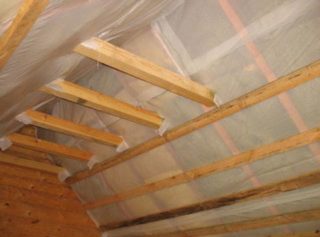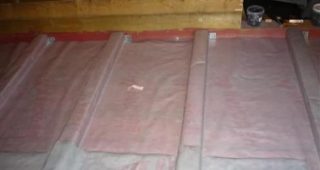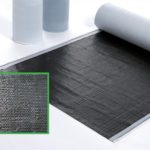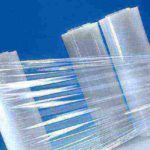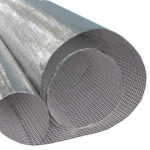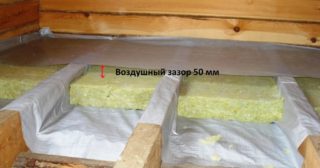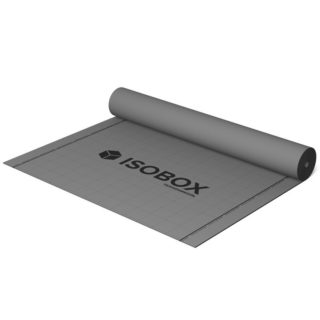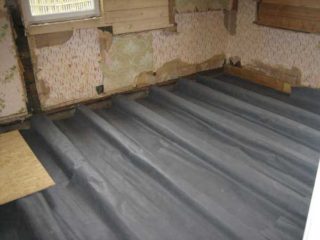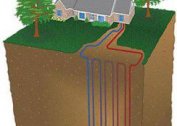During the construction or overhaul of buildings, it is important to properly prepare and level the surface. To prevent condensation, a special material is used. To provide effective protection against moisture, vapor barrier is needed. Which side to lay the membrane, sheet or film to the insulation depends on the type of surface.
Purpose of vapor barrier
Without a vapor barrier, when the temperature changes in winter, moisture penetrates into the insulation in contact with cold and warm air. It is in a state of condensation, but then transforms into water. In a humid environment, microbes and molds form, metal elements begin to rust. The hydrobarrier excludes these processes.
Dew point and vapor barrier
Inside the walls at the moment of contact of warm air masses from the room and the outside cold air, a dew point is reached. If condensation of water vapor occurs inside the thermal insulation coating, the material gets wet. It can deform and shrink, lose thermal conductivity.
Laying a vapor barrier will provide:
- protection of insulation, roofing and wall elements from moisture;
- withdrawal of the dew point outside the walls of blocks, concrete, brick, out;
- maintaining the strength of the building;
- prevention of the formation of unaesthetic and allergenic black mold;
- comfortable microclimate;
- reduction of costs for heating equipment and air conditioners.
The hydrobarrier is the only way to protect the room in the frame-panel house from moisture.
Which side do you need to mount the vapor barrier
Before putting vapor barrier to the insulation, you need to figure out which side to do this. Manufacturers produce products for one-sided or two-sided installation. The instructions usually indicate which side to fasten the material. If there is no manual, you can define the inside as
- the sides have a different color - light is placed on the insulation;
- when rolling, the inner layer is located below - it is directed towards thermal insulation;
- the outer layer is fleecy and does not allow moisture to pass through, the inside is smooth, so go to the insulation;
- polyethylene film can be placed on either side, vapor condensate - smooth on the heat insulate, so that it does not get wet when condensation forms;
- foil material is fixed with the reflecting part to the outside, isospan - after making a ventilation hole.
Roofing material is laid on either side with sealing joints.
Types of vapor barrier materials
Vapor barrier materials are distinguished by their strength and ability to drain condensate only if the installation technology is followed. To protect the house or other building from the appearance of the dew point, you can use several vapor isolates.
Polyethylene film
A dull vapor barrier that completely blocks moisture. The material has a thickness of 150 microns, is inexpensive. Minus polyethylene - the minimum life, deformation and tears in very warm rooms. It can be replaced with a vapor condensate film with a smooth inner surface and a rough outer one. Moisture does not penetrate through the barrier, but is kept on the smooth part.
Polypropylene film
Vapor barrier does not deform when exposed to cold and heat, and is durable. It consists of several layers:
- reinforcement - a mesh of film for mounting on a frame or crate;
- polypropylene - provides vapor barrier characteristics of the material;
- lamination - located on the outside, increases the performance of vapor impermeability.
The thicker the polypropylene, the less condensation it will let through.
Vapor barrier membranes
Available in the form of a two-layer non-woven material, designed for installation on insulation, supporting structures. They are distinguished by their durability, simple installation, and prevent the formation of dew when heating water, human breathing.
The membrane works on the principle of absorption and further evaporation of moisture. Thanks to the two-layer structure, the insulation does not get wet. Pile absorbs condensate and removes it, and the vapor-resistant layer does not allow water to pass through.
When choosing vapor barrier membranes, you need to focus on such factors:
- Sd (equivalent diffusion thickness) - a material with a higher index will have lower vapor resistance;
- permissible operating temperature - from -40 to +150 degrees;
- strength indicator - only a whole and sealed membrane will protect against condensation.
Installation of membranes should be carried out taking into account temperature, heating mode and room humidity.
Foil vapor barrier
The material due to the layered structure provides an effective vapor barrier. For the manufacture of the base, polypropylene, lavsan is used, for the upper part - aluminum foil. The material prevents the formation of steam and condensate inside the house, is a reflector of light radiation, protects the roof from the wind, reflects UV radiation in the summer.
The benefits of foil vapor barrier include:
- light weight - the canvas can be laid without first strengthening the structure;
- small thickness - the roofing cake and the bearing parts of the walls do not weigh down;
- lack of the need to organize a ventilation gap between the casing and the vapor barrier;
- plasticity - when laying easily takes any form;
- the ability to withstand temperatures up to +150 degrees - the material is suitable if there is a bathhouse or sauna on the site;
- speed of cutting with an office knife or scissors;
- ecological cleanliness - does not harm human health and the environment.
- Vapor permeable membrane
- Polyethylene film
- Foil film
Foil materials are a great way to save on heating because with their help, you can insulate the building.
Installation requirements
To properly install a vapor barrier film, the following rules must be observed:
- The roof slopes are made out with a continuous carpet - the rolled material must be connected with tape.
- Laying is carried out horizontally with a slight overlap.
- When mounting from the attic side, the insulation is laid with strips that go into the walls and floors of 15-20 cm.
- For fixing from the inside it is allowed to use a stapler.
- The best option for insulation for vapor barrier - rigid boards on a self-adhesive basis.
- Punctures, through cuts must be sealed with sealant or polyurethane foam.
- When using double-sided or superdiffusion membranes, ventilation gap is not needed.
- Before laying, the dew point is determined.
- In the presence of wooden structures, the barrier must be laid with a smooth surface to the insulation.
- If the insulation is outside, the vapor barrier must be inside.
- The film is stacked on window and doorways with a margin.
The film must be protected from sunlight.
Ceiling Layout Features
A diffusion membrane is suitable for finishing the ceiling.It is located on the insulation - rolled mineral or basalt wool. A heat-insulating coating is placed between the rafters and lags. The vapor barrier is mounted so that there is an overlap on the walls and the joints coincide with the lags. The corners are additionally worked out with tape.
Single sided materials
A propylene film with a laminate is laid with the smooth side on the insulation:
- The material is positioned so that it goes around the beam. The direction of the blade is perpendicular to the supporting structures.
- Laying with cutting into fragments and subsequent wrapping of beams with an overlap of 10-15 cm.
- Sealing joints. Double-sided tape is glued to the extreme part of the vapor barrier and fixed with an overlap. The film should sag 2 cm.
- Fastening the remaining layers so that the seam is offset by 30-40 cm.
Work is not performed in a humid room, during fogs, rains and snowfalls.
Bilateral materials
The film has a smooth and rough strontium. The latter should go outside - it retains drops of moisture and ensures their evaporation. A smooth vapor barrier prevents condensation. A 5 cm ventilation gap is left between the heater and the vapor barrier.
Foil film
The sheets are laid out so that the metal layer protrudes outward. It will reflect thermal radiation, maintain a pleasant microclimate, while taking away condensate.
Steam insulation
It is worthwhile to install a vapor barrier to protect the structure from moisture inside and out. Installation works are performed step by step:
- The choice of material and laying side. The foil membrane has a shiny side out.
- Material rolling parallel to the cornice. Between the cuts you need to overlap the walls about 15 cm.
- Fastening foil vapor barrier to staples with a special stapler.
- Sizing joints with metallic tape.
- Installation of a wooden crate for fixing the membrane and placing an external insulation.
- Thermal insulation fastening on the outside of the building.
- Laying additional insulation - mineral wool can be used to seal the crate cells.
- Installation of a diffusion membrane that takes steam out to the street and retains heat in the room.
- Organization of the ventilation gap in the form of a crate. The thickness of the rails forms the desired cavity.
At the last stage, a two-tier crate is installed in the form of perpendicular strips 25 mm in thickness.
Work with ventilated facades
For houses with ventilation facades, a membrane with moisture and wind protection properties is suitable. It will protect the thermal insulation from moisture and leakage of warm air masses. When laying the material, several rules must be observed:
- vapor barrier must be applied with the smooth part up;
- material direction - horizontally and vertically from top to bottom with an overlap of at least 50 cm;
- fastening points are selected according to the number of vent-façade fasteners, otherwise the membrane will be torn by the wind;
- the end part of the thermal insulation is located so that the upper layer of vapor barrier can go 25 cm under it.
Fire misfires should be 120 cm from the internal corners, doors, windows.
Laying a film vapor barrier on the floors with insulation
In order to protect the floor surface from moisture and condensation, a film can be laid. Before the start of work, insulation is carried out on the logs - mineral or basalt wool is placed in the cavity. At the same time as vapor barrier, water protection is organized on the first floor of the house.
In the area of the rooms using roll insulation film. It is placed with an overlap of 12-15 cm, and then the joints are carefully glued. The material starts up on the wall by 10 cm.
Vapor barrier of concrete floors is carried out at the last stage. At first, waterproofing is laid, then - insulation, and at the end - a film.
Installation of reflective vapor barrier
Cloths with foil are suitable for rooms where you need to keep heat as much as possible. The material is laid out with a reflective layer. A ventilation hole is arranged between it and the finish, which increases the heat-reflecting properties of the foil and eliminates the risks of condensation. Sections of the reflective vapor barrier are placed end-to-end and sealed with adhesive tape on a metal base.
Vapor barrier materials trap heat inside the house and prevent moisture from affecting the roof, walls and ceiling. The vapor barrier in living rooms is set with the rough side inwards, in baths and steam rooms with the smooth side inward.
